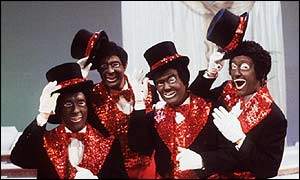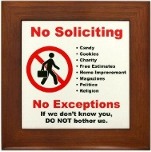Blackface!
|
|
Blackface performers are, "...the filthy scum of white society, who have stolen from us a complexion denied them by nature, in which to make money, and pander to the corrupt taste of their white fellow citizens." -- Frederick Douglass |
|
Minstrelsy evolved from several different American entertainment traditions; the traveling circus, medicine shows, shivaree, Irish dance and music with African syncopated rhythms, musical halls and traveling theatre. The "father of American minstrelsy" was Thomas Dartmouth "Daddy" Rice (1808-60), who in 1828, in a New York City theatre, performed a song-and-dance routine in blackface and tattered clothes. Rice's character was based on a folk trickster persona named Jim Crow that was long popular among black slaves. Rice also adapted and popularized a traditional slave song called Jump Jim Crow. |
||||
|
|
Come listen all you galls and boys Fist on de heel tap, |
|||
|
His act was an immediate sensation and while continuing to prefect the routine, Rice gained fame and fortune by performing it throughout the U.S. and in England. Read more about the origins of Jump Jim Crow and see it performed. |
||||
History of Minstrel Shows |
||||
|
In 1842, the songwriter Daniel Decatur Emmett and three companions devised a program of singing and dancing in blackface to the accompaniment of bone castanets, fiddle, banjo, and tambourine. Calling themselves the Virginia Minstrels, they made their first public appearance in February 1843 in a New York City theater.
The show was so popular that many imitators emerged while the demand for minstrel shows quickly became insatiable. In 1844, only one year after the first performance of the Virginia Minstrels, a blackface minstrel troupe called the Ethiopian Serenaders played at the White House for the "Especial Amusement of the President of the United States, His Family and Friends." Over time, minstrel shows developed into a standard format of three parts, developed by Edwin Christy, incorporating skits and songs performed in an imitation of black "plantation" dialect. In the first part, the show began with a walkaround -- the company marching onto the stage singing and dancing. A staple of walkaround was the cakewalk. White audiences loved the cakewalk, not realizing that it originated with plantation slaves imitating their master's walk. The troupe was then
seated in a semicircle, with one member on each end playing the
tambourine or the bones. The endmen were named Brother
Tambo and Brother
Bones, and they engaged in an exchange of jokes between the
group's songs and dances. It was customary for Tambo to be slim and Bones
to be fat. A character
called Mr. Interlocutor sat in the middle of the group, acting as the
master of ceremonies. As the interlocutor took his place in the middle of the semicircle
he uttered the time-honored phrase: "Gentlemen, be seated. We will commence with the
overture." During the performance he conducted himself in a dignified manner that
contrasted well with the behavior of the rowdy endmen.
Part two (the olio) was the variety section and a precursor to vaudeville. It included singers, dancers, comedians, and other novelty acts, and parodies of legitimate theater. A preposterous stump speech served as the highlight of this second act, during which a performer spoke in outrageous malapropisms as he lectured. His demeanor was reminiscent of the hilarious pomposity of Zip Coon; he aspired to great wisdom and intelligence, but his hilarious mangling of language always made him appear foolish and ignorant. Part three ended the show with a one-act play, typically a vignette of carefree life on the plantation. After Uncle Tom's Cabin was published in 1852 and the play became famous, minstrel shows appropriated the major characters for sketches that changed the abolitionist themes in the original into an argument for the supposedly benign character of slavery. Although the structure of minstrel shows changed over time, the images -- blackface -- and the content -- caricatures of Blacks -- continued. Prior to the Civil War (1861-1865), pro-slavery Whites used the racist stereotypes as a way of countering the abolitionist movement. Performers defended slavery by presenting denigrating stereotypes of Blacks who supposedly needed the civilizing influence of slavery to keep them in check. Black slaves were portrayed as happy and content with their lot in life and fearful of life outside of the plantation. With the dramatic increase in the popularity of minstrel shows in the years following emancipation, Whites continued to wear the blackface mask in performances that would serve to define the meaning of blackness for many Americans who by choice or geography had little contact with Blacks.
One of the first Blacks to perform in blackface for White audiences was William Henry Lane, the inventor of tap dancing who was known to audiences as Master Juba. When Blacks began to work as minstrels in the mid-1840s, becoming established as performers by the 1860s, their contribution ironically did little to alter the tradition. Indeed, it only reinforced the racist Black stereotypes already ingrained both in the theater and in the society. Initially, Blacks were able to participate in minstrel shows only by declaring themselves "real coons." To meet the expectations of both White and Black audiences, Black minstrels donned burnt cork to blacken their already dark skin and performed comedy routines using the traditional caricatures and racist stereotypes.
Some of the most popular songs in American history began as minstrel songs -- "Dixie", "Oh! Susanna", "Camptown Races", "Old Folks at Home" ("Swanee River"), " Polly Wolly Doodle", "Hard Times Come Again No More", "My Old Kentucky Home", "Jeannie With the Light Brown Hair", and "Blue Tail Fly". All were written by Stephen Foster, the most famous songwriter of the 19th century in the United States. From 1850 to 1870 minstrelsy was at its height, and in the 1850s ten theaters in New York City alone were devoted almost solely to minstrel entertainment. After 1870, the popularity of the minstrel show declined rapidly, and in 1919 only three troupes remained in the U.S. However minstrel show acts continued to be depicted in the cinema and on television well into the 1950s. Amateur minstrel shows continued to be performed in the 1960s and high schools, fraternities and local theater groups would usually perform the shows in blackface. The amateur minstrel shows in blackface finally died out in the US in the late 1960s as African Americans asserted more political power, but even today minstrel shows are still used as a theme for amateur productions.
|
||||
|
|
 The Black And White Minstrel Show on Television |
|||
|
And blackface minstrel shows lived on in other parts of the world. One hundred years after minstrel entertainment began in London's music-halls, the convention was revived on television in the form of The Black And White Minstrel Show. This variety series was first screened on BBC Television in 1958 and it was on the air until 1978. At the height of its success, The Black and White Minstrel Show was watched by 18 million viewers a week and had become one of the world's best known musical/variety shows on television.
Minstrel Show Female ImpersonatorsGeorge Christy was probably the first famous female impersonator in minstrel shows when he played the part of Miss Lucy Long in the 1840s. By the mid-1850s most major companies had female impersonators (Wenches and Prima Donnas). Two of the most famous performers were "The Only Leon" and Tony Hart. Stephen Foster (1826-1864)Stephen Foster wrote many of the most popular songs of the minstrel era, but as an artist, Foster longed to earn recognition for songwriting and composing other types of music that were considered less trivial than minstrel shows. |
||||

Buy a No
Soliciting Sign
That Really Works!
|
|
|||||
|
|
Visit the Blackface! YouTube Channel for more blackface and minstrel show videos |
||||
|
|
|||||
Racial and Racist Stereotypes in Media |
|||||
|
Blackface! Black Stereotypes |
Yellowface! Asian Stereotypes |
 Brownface! Hispanic Stereotypes |
Redface! Indian Stereotypes |
Arabface! Arab Stereotypes |
Jewface! Jewish Stereotypes |
|
|
|||||
| Please visit our partners: |
| Buy * Will Write for Food * T-shirts |
| Kachina.us - Guide to Hopi Kachina Dolls |
| Agile Writer -- Biography and History |
Copyright ©
Ken Padgett